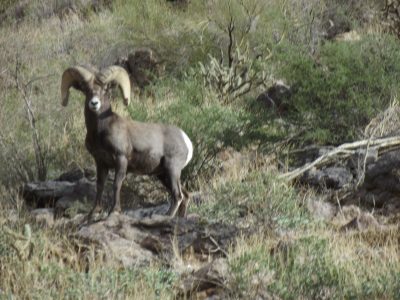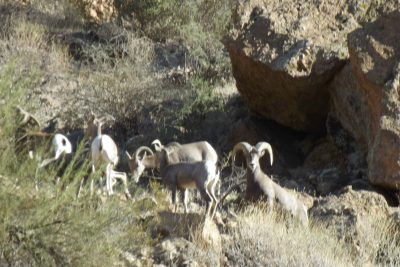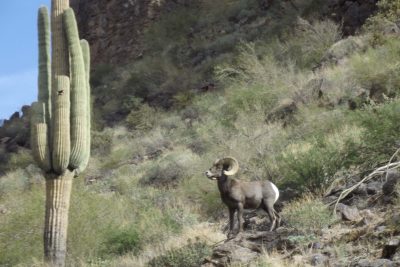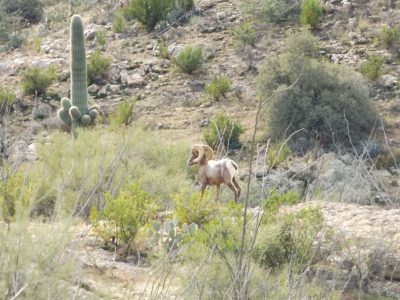
Bighorn sheep in Arizona
Jerry and I roll our four wheel drive vehicles across the rough and rocky road known as Telegraph Pass in the Picket Post Mountains when suddenly a bighorn ram crosses the road. He is a magnificent beast, a thick muscular body with a large pair of horns which curve all the way around his head and past his ears. The ram is far too quick for me to take a photograph and disappears in the desert scrub. Moments later the ram reappears atop a hill and stares at our vehicles as we roll slowly past. This time I get my photograph.
Jerry says, “I think that is the biggest bighorn sheep I have ever seen – even bigger than the one we saw at Canyon Lake.”
I have been fortunate to see bighorn sheep many places, many different times but the one place I have never seen bighorn is in the Santa Catalina Mountains. They lived in the Pusch Ridge area when I was a growing boy and as a young man I spent many afternoons getting torn up by acacia bushes searching for the elusive beasts. The sightings of bighorn in the Catalinas became rarer until they were determined to have disappeared entirely from the region by the 1990s. In recent years, there have been extensive and expensive sheep reintroduction efforts in these mountains. The problem is this part of the mountain has not seen a large wildfire in many years and the thick underbrush makes the bighorn easy prey for ambush. Every time they release new bighorn onto Pusch Ridge they quickly succumb to predators. Personally, I am okay with feeding the mountain lions but the sheep will not survive until they burn off the underbrush.

Bighorn sheep in Arizona
My first encounter with a bighorn was while hiking up the Bright Angel trail of the Grand Canyon. It was a pair of female ewes, (probably mother and daughter) who hopped along the trail, waiting nervously to see if I would follow. I had no choice – they were on the trail. When they got bored of me they scampered off a cliff where I never could have followed. Every time I have backpacked Aravaipa Canyon I have seen bighorn scampering atop the canyon walls. Sometimes you do not have to wander deep into the wilderness to discover bighorn sheep. I have seen bighorn sheep while driving the highway from Kingman to Hoover Dam when spotting a small herd of bighorn just off the side of the highway. Jerry pulled into the Morenci library parking lot one day and was greeted by a herd of six bighorn sheep.
One place where I used to regularly see bighorn was the Silverbell Mine in the Silverbell Mountains. Water would puddle on the flat terraces of the open pit mine and the sheep often paused there to drink. Just after the creation of the Ironwood Tree National Monument, which includes the Silverbell Mountains on the northern perimeter a goat herder brought in a herd of goats which were infected with a contagious eye disease. Three years ago, Jerry and I went hiking in the Silverbell range and near the top of a rocky crag, in a place where animals were bedding there was the unmistakable smell of sheep urine. At least the smell was unmistakable if you have ever spent time in the 4-H section of a county fair.

Bighorn sheep in Arizona
I had the privilege of participating in Cabeza Prieta bighorn sheep surveys for two years in a row. Located on the Arizona Mexico border, the Cabeza Prieta Wildlife Refuge and Bombing Range is one of the largest wildlife refuges in the country and it is also one of the hottest, driest deserts in the world. The bighorn sheep surveys used to take place in the middle of July, during the hottest part of the summer. The Cabeza Prieta is roughly the size of Connecticut and yet there are only seven watering holes in the entire place. Bighorn sheep are well adapted to the desert and do not have to drink often. It was reasoned that when the temperature was well into the hundred and teens the sheep will have to drink more often. Each of the watering holes has a blind where observers are supposed to wait and count the sheep or anything else which comes to drink. Mostly observers sit and wait, marveling at how incredibly hot it is. I do remember the thrill, when after four brutally hot days, a mother and her young son, worked their way down the rocky crag to drink, so wary and cautious, so athletic. The young ram turned his head and for just a moment his head and curving horns cast a perfect silhouette shadow upon the granite boulder. It was a breathtaking moment which I will never forget.

Bighorn sheep in Arizona
While researching the traditions of bighorn sheep in the region I stumbled upon some amazing histories. When Spanish conquistador Juan Bautiste de Anza was roaming through the Estrella Mountains outside Phoenix in the 1770’s he came upon Pima villages that forsook the growing of corn and based their economy upon hunting sheep. Every village placed stacks of bighorn sheep skulls at the four corners to protect the village from storms, wind, rain and lightning. It was said that a good shaman could bring a rainstorm armed only with a bighorn sheep skull and some saguaro fruit wine. The last shaman said to have this power was an O’odham sorcerer named Jose Juan who was interviewed by the Norwegian anthropologist Lumholz in 1908. Jose Juan was reported have been well over one hundred years old at the time. This did not stop Jose Juan from being interviewed by the geographer Ives in 1939. Julian Hayden interviewed the son, Jose Juan, during a bighorn hunting expedition. Jose Juan ritually burned the bones in the fire. The O’odham are the only tribe in North America that ritually burns the bones of game animals. This is a practice that goes back to the mammoth hunters. It has always amazed me that here in Arizona, in one of the driest deserts in the world, people are keeping alive a tradition which goes back to the Ice Age.
My favorite way to see bighorn sheep is while kayaking Canyon Lake. The normally shy sheep do not seem very intimidated by the kayaks. The best time to kayak Canyon Lake is during December and January when motorboat traffic (and their accompanying rough waves) are at their lightest. One time when Jerry and I were kayaking Canyon Lake we had three bighorn sightings in one day. The first was a small herd of sixteen. The second sighting was a pair of sharp silhouettes high atop the canyon walls. The third time we floated upon a huge ram. He was big stout, and muscular. The ram was not intimidated by us at all. As we slowly floated towards him, taking photographs the whole time, instead of running away, he snorted and stamped his feet. There is no doubt in my mind, that had we been on land he would have charged us. I even wondered what I would do if he charged us, leapt into the water and began swimming towards us. He snorted and stomped with no intention of leaving. It was obvious he expected us to leave. He was one macho hombre.
When I get back home from the Picket Post Mountains, I compare my photos of the Telegraph Pass Bighorn with the one from Canyon Lake and in the end it does not matter which ram is bigger. As long as I am out exploring Arizona and seeing bighorn sheep – life is good.

